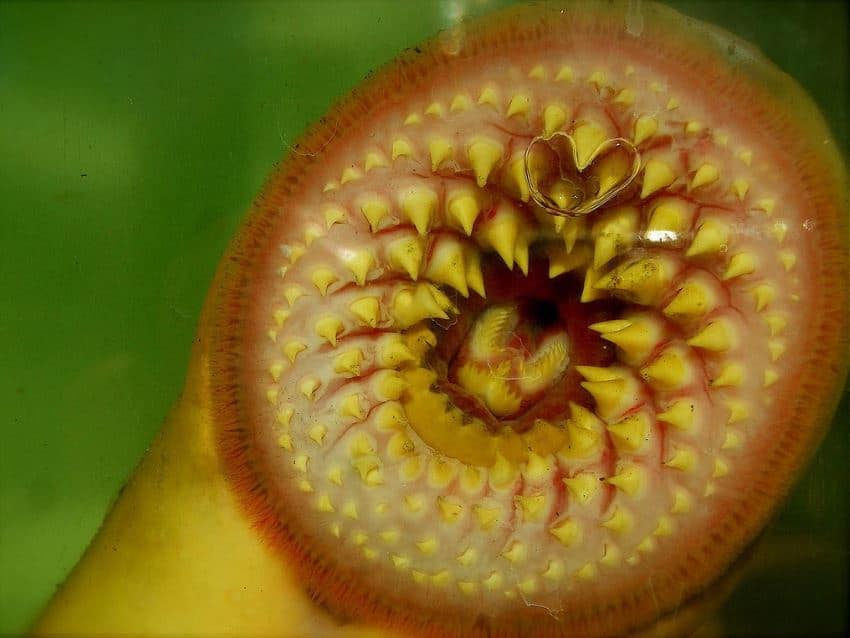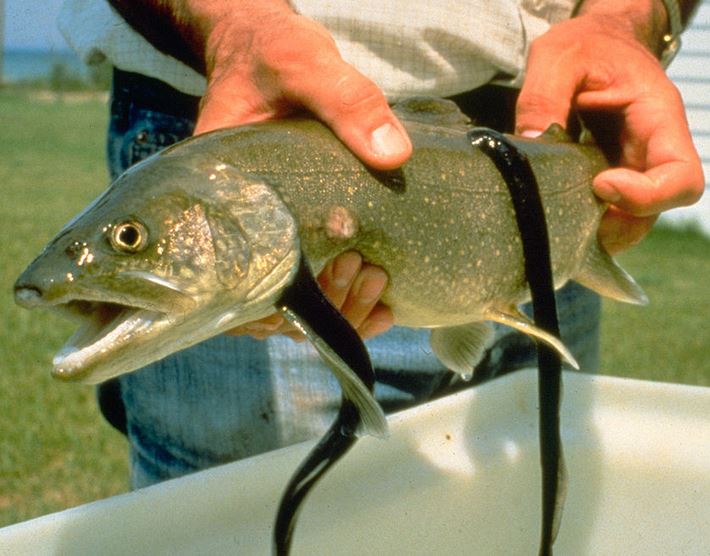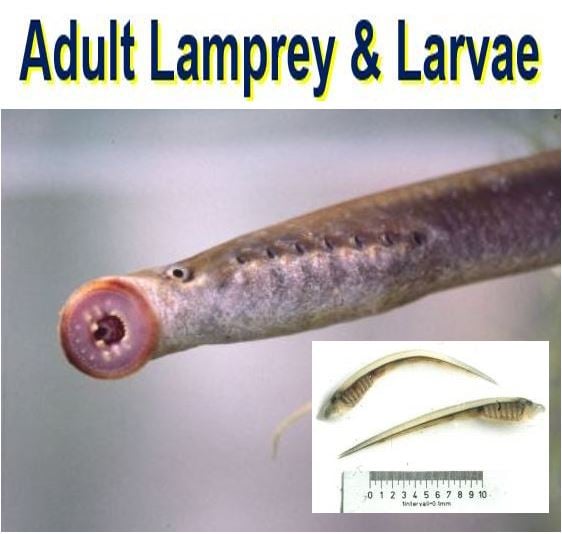Blood sucking sea lampreys have are back in English rivers in alarmingly growing numbers – swimmers going for a bathe are being told to beware of these parasitic creatures that latch onto human skin and drink your blood. When they feed on fish, they literally drain the life out of them.
Sea lampreys (Petromyzon marinus) are most likely to be seen in rivers at this time of year as the adults make their way upstream to spawn (deposit eggs).
They may be fascinating creatures, Rokur writes in the website Swimmer’s Daily, “but good looks are not one of their attributes.”
 The sea lamprey has an eel-like body with no paired fins. It has a round, sucker-like, jawless mouth which is as wide (sometimes wider) as its head. A series of razor-sharp teeth are arranged in several circular rows. (Image: Swimmer’s Daily)
The sea lamprey has an eel-like body with no paired fins. It has a round, sucker-like, jawless mouth which is as wide (sometimes wider) as its head. A series of razor-sharp teeth are arranged in several circular rows. (Image: Swimmer’s Daily)
The increase in lamprey numbers – often referred to as ‘vampire fish’ – which kill other fish by latching onto them and sucking their blood, has been mentioned on several outdoor swimming websites as the warmer season approaches.
Permanently open mouth filled with razor-sharp teeth
They look a bit like eels and have an open mouth filled with a great many razor-sharp teeth that look like rose-bush thorns.
Rokur writes:
“Perhaps the most extraordinary thing about them is that they have been around since well before the dinosaurs, and with 360-million-year-old fossils looking remarkably like modern lampreys, they are said to be the oldest vertebrates.”
 Lampreys feeding on a lake trout. (Image: Wikipedia)
Lampreys feeding on a lake trout. (Image: Wikipedia)
While thriving for all those hundreds of millions of years, not that long ago they suffered enormously in the UK from human interference with river flow and pollution. Human interference prevented them from reaching their spawning destinations, that is, until recently.
Since the rivers have been cleaned up, and thousands of miles cleared of obstructions for migrating fish, sea lampreys are re-colonising rivers, including the Wear, Trent, Derwent and Great Ouse, where this creature had not been spotted for decades.
How do lampreys feed?
Lampreys use their suction cup-like mouth to attach themselves to the skin of a fish. Their sharp, keratinized teeth and probing tongue rasp away at tissue. Secretions in the creature’s mouth prevent the victim’s blood from clotting.
The victim usually dies from excessive blood loss or infection. This does not mean that you would die if one latched onto you. We know how to get them off, fish don’t.
In South-Western France and some other parts of Europe, lampreys are considered a delicacy. They are not commonly eaten in the UK, Ireland or the Americas.
 An adult lamprey and two Ammocoetes (larval stage of lamprey). Ammocoetes live buried in freshwater silt and feed on minute particles. After several years they metamorphose into adult lampreys and migrate into nursery areas. They then move to the sea, and return to freshwater to spawn during the spring and early summer. The adults die after spawning. (Image: cardiganbaysac.org.uk)
An adult lamprey and two Ammocoetes (larval stage of lamprey). Ammocoetes live buried in freshwater silt and feed on minute particles. After several years they metamorphose into adult lampreys and migrate into nursery areas. They then move to the sea, and return to freshwater to spawn during the spring and early summer. The adults die after spawning. (Image: cardiganbaysac.org.uk)
Sea lampreys are found in the northern and western Atlantic Ocean along the shores of North America and the Great Lakes, Europe, the Black Sea, and the western Mediterranean.
The species has been found at depths of up to four thousand metres, and can tolerate temperatures between 1 and 20 Celsius.
Three species native to Britain
According to Scottish Natural Heritage, there are three lamprey species present in UK: 1. Brook lamprey (Lampetra planeri). 2. River lamprey (Lamprey fluviatilis). 3. Sea lamprey (Petromyzon marinus).
River lamprey are larger that brook but smaller than sea lamprey, reaching a length of 30 to 50 cm. They migrate from their coastal feeding grounds into freshwater, where they spawn in the spring and autumn.
Sea lampreys are the largest, reaching a length of about one metre. After spending up to two years feeding at sea, the adult migrates into rivers during the spring and early summer. Scottish Natural Heritage says they spawn from May to July in areas of pebble and cobble substrate.
In the UK sea lampreys are a protected species, unlike the Great Lakes of North America, where they are regarded as a serious non-native pest. In North America, this species causes significant damage to sport fishery – millions of dollars are spent controlling sea lamprey numbers.
Video – Lamprey sucks human blood
In this Discovery Channel Asia video, a lamprey sucks Jeremy Wade’s blood from his body.
